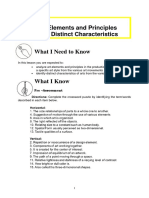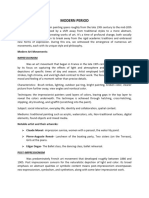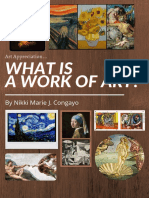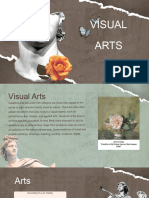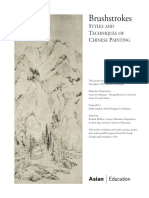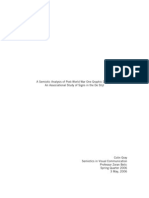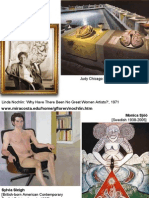Professional Documents
Culture Documents
Lesson 2
Lesson 2
Uploaded by
John Van Dave Taturo0 ratings0% found this document useful (0 votes)
105 views51 pagesThe next section discusses Cubism, which emphasized the formal structure of art and reducing forms to geometric equivalents. Surrealism sought to blend dreams
Original Description:
Original Title
Lesson-2
Copyright
© © All Rights Reserved
Available Formats
PPTX, PDF, TXT or read online from Scribd
Share this document
Did you find this document useful?
Is this content inappropriate?
Report this DocumentThe next section discusses Cubism, which emphasized the formal structure of art and reducing forms to geometric equivalents. Surrealism sought to blend dreams
Copyright:
© All Rights Reserved
Available Formats
Download as PPTX, PDF, TXT or read online from Scribd
Download as pptx, pdf, or txt
0 ratings0% found this document useful (0 votes)
105 views51 pagesLesson 2
Lesson 2
Uploaded by
John Van Dave TaturoThe next section discusses Cubism, which emphasized the formal structure of art and reducing forms to geometric equivalents. Surrealism sought to blend dreams
Copyright:
© All Rights Reserved
Available Formats
Download as PPTX, PDF, TXT or read online from Scribd
Download as pptx, pdf, or txt
You are on page 1of 51
IMPRESSIONIS
MCharacterized by short brisk strokes of bright colors used to
recreate the impression of light on objects.
It portrays the effects of experience upon the consciousness of the
artist and the audience. The artist is characterized as one concerned
more with the technique of suggesting light and color to the picture
than with the subject matter
A scene may either be in natural setting or a man-made landscape,
but outdoors are generally the subject, with vibrant colors without an
emphasis on details.
Impressionism enabled the artist to paint an image in the way that
someone might see it if they only caught a quick glimpse of the
subject.
This method allowed the artists to emphasize the impression of their
subject matter rather than paint the object in a more realistic manner.
IMPRESSIONIS
M
SUNRISE Rose Arches
by
Claude Monet
DANCE CLASS SELF PORTRAIT
by Degas By Cassatt
EXPRESSIONIS
M
It is a manner of painting and sculpturing in which natural
forms and colors are distorted and exaggerated.
The artist uses free distortion of form and color through
which he gives visual form to inner sensations or emotions.
The paintings, the primary art of which expressionism
influenced, are full of vivid imagery and emotion and are often
described as showing a touch of the dark side of human nature.
Expressionist artist show emotions and personal views in their
work. They portray subjective reality rather than realism.
Artist might incorporate fantasy and violence in their subject
matter in order to show the extremes of emotion.
EXPRESSIONISM
EXPRESSIONISM
EXPRESSIONISM
EXPRESSIONISM
EXPRESSIONISM
ABSTRACT
EXPRESSIONISM
Abstract art is conceived apart from any realities, or specific
objects. It pertains to the formal aspects of art in emphasizing
lines, colors, and generalized geometric forms. This kind of art is
a logical extension of cubism with its fragmentation of the
object.
It is a post-World War II art movement that developed in New
York in the 1940s. There were actually no established styles,
although the works put an emphasis on dynamic and energetic
gesture. The imagery used primarily still abstract.
ABSTRACT
EXPRESSIONISM
Two broad groupings:
1. ACTION PAINTERS
2. COLOR FIELD PAINTERS
ABSTRACT
EXPRESSIONISM
ACTION PAINTERS
The artists worked in a spontaneous improvisatory
manner often using large brush to make sweeping gestural
marks.
COLOR FIELD PAINTERS
The artists were deeply interested in religion and
myth; and created simple compositions with large areas
of single color intended to produce a contemplative or
meditational response in the viewer.
ABSTRACT
EXPRESSIONISM
ABSTRACT
EXPRESSIONISM
ABSTRACT
EXPRESSIONISM
ABSTRACT
EXPRESSIONISM
ABSTRACT
EXPRESSIONISM
CUBISM
It is considered as the most influential
art movement in the 20th century
Characterized by an emphasis on the
formal structure of a work of art and the
reduction of natural forms of their
geometrical equivalent.
CUBISM
CUBISM
CUBISM
CUBISM
CUBISM
CUBISM
CUBISM
CUBISM
SURREALIS
MIt was an art movement that sought to link the
world of dreams with real life.
It was founded in Paris by a small group of
writers and artist who sought to channel the
unconscious as a means to unlock the power of
the imagination.
SURREAL – means beyond or above reality
SURREALISM
SURREALISM
SURREALISM
SURREALISM
SURREALISM
SURREALISM
SURREALISM
SURREALISM
REALISM
Another style of art whose interest and concern centers
around the actual or real problems. It deviates on the
treatment of forms, colors, and space, as they appear in
actuality or ordinary visual experience.
Used pure, brilliant colors applied straight from the paint
tubes in a bold direct manner to create an explosive effect
on the canvas. Artist of this style were called FAUVES
REALISM or FAUVISM
REALISM or FAUVISM
REALISM or FAUVISM
REALISM or FAUVISM
REALISM or FAUVISM
REALISM or FAUVISM
DADAIS
M
It is a style of painting which is a protest against the horrors of
World War I, which artists believed had been a show of barbarism
and oppressive intellectual rigidity in both art and everyday society.
The art was characterized by a deliberate irrationality and the
rejection of the prevailing standards of art.
DADA artists referred their work as to have not been influenced by
any movement, basic principles can be seen greatly from Cubism,
and Expressionism.
DADAISM
DADAISM
DADAISM
DADAISM
DADAISM
DADAISM
Activities:
1. Summarize the lesson according to what you have
understand.
2. Criticize the examples of every styles of art and
choose one from the given examples to explain
according to what you have observe.
3. Since this is an Art Appreciation subject, draw the
following styles of art on a clean band paper.
• Impressionism
• Cubism
• Realism
Note: You can use any coloring materials as long as you
have it in your house.
You might also like
- Nursing Care OF A Family Experiencing A Pregnancy From A Preexisting OR Newly Acquired IllnessDocument55 pagesNursing Care OF A Family Experiencing A Pregnancy From A Preexisting OR Newly Acquired IllnessJohn Van Dave TaturoNo ratings yet
- Intellectual Revolution: Science Technology and SocietyDocument19 pagesIntellectual Revolution: Science Technology and SocietyJohn Van Dave TaturoNo ratings yet
- Art and The Human FacultiesDocument9 pagesArt and The Human FacultiesRyuen ChouNo ratings yet
- Hazel Harrison - Pastel School PDFDocument184 pagesHazel Harrison - Pastel School PDFJan100% (8)
- Finished Project ProposalDocument2 pagesFinished Project Proposalapi-459504976100% (1)
- Art Styles 3 PDFDocument68 pagesArt Styles 3 PDFMarie Joy GarmingNo ratings yet
- Arts 10 - Q1Document76 pagesArts 10 - Q1Rjay NagilNo ratings yet
- 01 - Understanding Humanities, Arts, Art History & Art AppreciationDocument12 pages01 - Understanding Humanities, Arts, Art History & Art AppreciationVoxdeMacNo ratings yet
- Chapter 2.3.3 History of Visual Arts Modernism Post ModernismDocument17 pagesChapter 2.3.3 History of Visual Arts Modernism Post ModernismKim Ashley SarmientoNo ratings yet
- Grade10 Modern Art Impressionsim-ExpressionismDocument106 pagesGrade10 Modern Art Impressionsim-ExpressionismRonnel Andres Hernandez100% (6)
- Arts 10: Impressio NismDocument45 pagesArts 10: Impressio NismFrank BarcenasNo ratings yet
- LESSON 4 - PaintingDocument97 pagesLESSON 4 - PaintingHiro Jemmima RenoudNo ratings yet
- Grade 10 Unit One. Modern ArtDocument1 pageGrade 10 Unit One. Modern ArtRonnel Andres HernandezNo ratings yet
- Impressionism Vs Expressionism: by Daisy MariposaDocument4 pagesImpressionism Vs Expressionism: by Daisy MariposaMaria Fe VibarNo ratings yet
- What Is Expressionism and How Can I Apply My Artistic Skills in Making An Expressionism Artwork?Document4 pagesWhat Is Expressionism and How Can I Apply My Artistic Skills in Making An Expressionism Artwork?Heziel Caberto FrianezaNo ratings yet
- ART STYLES (Art Movements)Document27 pagesART STYLES (Art Movements)ArianneNo ratings yet
- Arts 10 W1 2Document12 pagesArts 10 W1 2Ian Jay A. BahiaNo ratings yet
- Expressionism ArtDocument18 pagesExpressionism ArtmememiaNo ratings yet
- Act 5 - GEE12Document6 pagesAct 5 - GEE12Marelene AgudoNo ratings yet
- Arts Module For First QuarterDocument23 pagesArts Module For First QuarterLorjnn Lapinig100% (1)
- Arts 10 LessonDocument56 pagesArts 10 LessonPrincess MerryNo ratings yet
- AAC. MM 3-1 Methods of Presenting ArtDocument10 pagesAAC. MM 3-1 Methods of Presenting ArtJeon ArmyNo ratings yet
- Methods of Presenting SubjectsDocument39 pagesMethods of Presenting SubjectsMaureen Joy CabelNo ratings yet
- MAPEH10 ARTS Q1 - Mod 1 Art Movements V3Document87 pagesMAPEH10 ARTS Q1 - Mod 1 Art Movements V3Hazel Milanes100% (1)
- Arts Reviewer 8915Document7 pagesArts Reviewer 8915queridaria47No ratings yet
- Art StylesDocument1 pageArt StylesCasmier ArbalateNo ratings yet
- Expressing Art SubjectDocument41 pagesExpressing Art SubjectLoreen LucanaNo ratings yet
- Methods of Presenting Art SubjectDocument39 pagesMethods of Presenting Art SubjectJef JepoyNo ratings yet
- Outline ArtsQ1Document2 pagesOutline ArtsQ1Pool DeadNo ratings yet
- Lessons in Co Art 1 To 3Document7 pagesLessons in Co Art 1 To 3Leah RoseNo ratings yet
- Abstructionism: Sta - Monica, Matthew BSIT 21T4Document4 pagesAbstructionism: Sta - Monica, Matthew BSIT 21T4Matthew Sta. MonicaNo ratings yet
- Arts Module 2Document47 pagesArts Module 2Purple Shines100% (1)
- 2 Art Movement and StylesDocument33 pages2 Art Movement and StylesFlorence Lynn BaisacNo ratings yet
- Art Styles Modern ArtDocument66 pagesArt Styles Modern ArtKimberly Rose VillacentinoNo ratings yet
- DO Arts-10 q1 Mod2 Wee2-3Document17 pagesDO Arts-10 q1 Mod2 Wee2-3Herdie Anne LedesmaNo ratings yet
- PAINTING (Modern and Contemporary Period)Document14 pagesPAINTING (Modern and Contemporary Period)Sittie Asraleah AgatonNo ratings yet
- Nikki Congayo MagazineDocument52 pagesNikki Congayo MagazineNikki CeeNo ratings yet
- Mapeh 10-Week 6Document3 pagesMapeh 10-Week 6Edmar MejiaNo ratings yet
- The ExpressionismDocument4 pagesThe ExpressionismSantiago González ValenciaNo ratings yet
- Methods in Presenting The Art SubjectsDocument8 pagesMethods in Presenting The Art SubjectsjazzieballadoNo ratings yet
- Grade 10 Arts: Pacucoa Accredited: Level Ii S.Y. 2022-2023Document2 pagesGrade 10 Arts: Pacucoa Accredited: Level Ii S.Y. 2022-2023Copioso,Kisha Danise D.No ratings yet
- 3 MapehDocument4 pages3 MapeheboypjmsNo ratings yet
- Quarter I Modern ArtDocument8 pagesQuarter I Modern Artlivija mikicNo ratings yet
- SOC. SCI 415: Professor: Dr. Vima OlivaresDocument61 pagesSOC. SCI 415: Professor: Dr. Vima OlivaresCharmaine JanorasNo ratings yet
- Brown Doodle Company Profile PresentationDocument11 pagesBrown Doodle Company Profile PresentationWil UfanaNo ratings yet
- Reading Visual Arts Topics For FridayDocument8 pagesReading Visual Arts Topics For FridaySakura BlossomsNo ratings yet
- ART-GENRESDocument24 pagesART-GENRESLaedie Jane Alcano AguilarNo ratings yet
- Grade 10 Arts Q1 1Document24 pagesGrade 10 Arts Q1 1JhasminKim PendillaNo ratings yet
- Grade 10 Arts PPT Quarter 1 Complete W Assessment 1Document58 pagesGrade 10 Arts PPT Quarter 1 Complete W Assessment 1Regner BorneoNo ratings yet
- Chapter 2METHODS OF PRESENTINGDocument2 pagesChapter 2METHODS OF PRESENTINGThomas EdisonNo ratings yet
- Lesson 3: Filipino Artists and Their Contributions To Particular Art FormsDocument29 pagesLesson 3: Filipino Artists and Their Contributions To Particular Art FormsAisah IbrahimNo ratings yet
- Ways of Presenting The SubjectDocument2 pagesWays of Presenting The SubjectMovie and ChillNo ratings yet
- Lesson 3 GNED01Document33 pagesLesson 3 GNED01ABCEDE, ANDREANo ratings yet
- Colorful Modern Creative Presentation - 20240330 - 012254 - 0000Document14 pagesColorful Modern Creative Presentation - 20240330 - 012254 - 0000Wilbert ZialcitaNo ratings yet
- MAPEH Arts Grade10 Quarter1 Module2 Week3-4Document11 pagesMAPEH Arts Grade10 Quarter1 Module2 Week3-4xander ison100% (1)
- ImpressionismDocument13 pagesImpressionismXyra BarroNo ratings yet
- PAINTINGDocument4 pagesPAINTINGJH QuiambaoNo ratings yet
- GE ART Lesson 1Document50 pagesGE ART Lesson 1kentmark guibaoNo ratings yet
- Art Lesson Q1 Day1Document4 pagesArt Lesson Q1 Day1Jamela PalomoNo ratings yet
- Modern Art FinalDocument75 pagesModern Art FinalGLADYS MAE DELA PENANo ratings yet
- Impressionism ArtDocument57 pagesImpressionism Artcabalcabal075No ratings yet
- G10 Q1 Arts Module 1Document19 pagesG10 Q1 Arts Module 1Manuel Rosales Jr.50% (2)
- Methods of Presenting Art Subject Yom2Document19 pagesMethods of Presenting Art Subject Yom2Jose MariNo ratings yet
- Modern Art Grade 10Document13 pagesModern Art Grade 10Tish Shamir MonisNo ratings yet
- Factsheet No WaveDocument6 pagesFactsheet No WaveJohn Van Dave TaturoNo ratings yet
- Table-Of-specifications (Tos Diagnostic) 2022-2023Document1 pageTable-Of-specifications (Tos Diagnostic) 2022-2023John Van Dave TaturoNo ratings yet
- ScienceDocument11 pagesScienceJohn Van Dave TaturoNo ratings yet
- Earth's MechanismDocument22 pagesEarth's MechanismJohn Van Dave Taturo100% (2)
- Group 2 YakalDocument9 pagesGroup 2 YakalJohn Van Dave TaturoNo ratings yet
- Feminist Literary CriticismDocument62 pagesFeminist Literary CriticismJohn Van Dave Taturo100% (1)
- NI Module Powered by ARS Chapter 1 2Document10 pagesNI Module Powered by ARS Chapter 1 2John Van Dave TaturoNo ratings yet
- NCM 114 Midterm Module ContentDocument54 pagesNCM 114 Midterm Module ContentJohn Van Dave TaturoNo ratings yet
- Medical EthicsDocument58 pagesMedical EthicsJohn Van Dave TaturoNo ratings yet
- The Concept of Community: Prepared By: April Joy F. Bolodo, LPTDocument25 pagesThe Concept of Community: Prepared By: April Joy F. Bolodo, LPTJohn Van Dave TaturoNo ratings yet
- Aspect of GlobalizationDocument7 pagesAspect of GlobalizationJohn Van Dave TaturoNo ratings yet
- Learning Module in NCM 114 Pre FinalDocument77 pagesLearning Module in NCM 114 Pre FinalJohn Van Dave TaturoNo ratings yet
- Communit Y Immersion: Prepared By: April Joy F. Bolodo, LPTDocument26 pagesCommunit Y Immersion: Prepared By: April Joy F. Bolodo, LPTJohn Van Dave TaturoNo ratings yet
- Chapter 3: Role of Informatics Nurse Specialist (Week 4) Intended Learning Outcomes (ILO)Document10 pagesChapter 3: Role of Informatics Nurse Specialist (Week 4) Intended Learning Outcomes (ILO)John Van Dave TaturoNo ratings yet
- Intended Learning Outcomes: Unit 1: Implementing GuidelinesDocument13 pagesIntended Learning Outcomes: Unit 1: Implementing GuidelinesJohn Van Dave TaturoNo ratings yet
- UNIT 3: Computer Usage For Nurse Informaticists Chapter 4: Introduction To Software (Week 6) Intended Learning Outcomes (ILO)Document28 pagesUNIT 3: Computer Usage For Nurse Informaticists Chapter 4: Introduction To Software (Week 6) Intended Learning Outcomes (ILO)John Van Dave TaturoNo ratings yet
- Learning Module in NCM 114 FinalDocument101 pagesLearning Module in NCM 114 FinalJohn Van Dave Taturo100% (1)
- NCM 114 Unit 1 To 4 GeriaDocument85 pagesNCM 114 Unit 1 To 4 GeriaJohn Van Dave Taturo100% (1)
- Screening and Diagnostic Test For Chromosomal DisordersDocument21 pagesScreening and Diagnostic Test For Chromosomal DisordersJohn Van Dave TaturoNo ratings yet
- Unit 1 - Week (1) - Comprehensive Assessment: Intended Learning Outcomes (Week 1-ILO)Document28 pagesUnit 1 - Week (1) - Comprehensive Assessment: Intended Learning Outcomes (Week 1-ILO)John Van Dave TaturoNo ratings yet
- Module 3 ReviDocument35 pagesModule 3 ReviJohn Van Dave TaturoNo ratings yet
- Learning Module in Physical Education 4 SportsDocument31 pagesLearning Module in Physical Education 4 SportsJohn Van Dave Taturo0% (1)
- STS Module Powered by ARS CHAPTER 1Document15 pagesSTS Module Powered by ARS CHAPTER 1John Van Dave Taturo100% (1)
- Arta Prelim Exam ReviewerDocument7 pagesArta Prelim Exam ReviewerFaithNo ratings yet
- Medieval ArtDocument36 pagesMedieval ArtDama MoralloNo ratings yet
- ParkBooks International New Titles 2017 18 ScreenDocument32 pagesParkBooks International New Titles 2017 18 ScreenDelia NechitaNo ratings yet
- Art406 AssignmentDocument9 pagesArt406 Assignmentabhishek bansalNo ratings yet
- Joaquin - Semi Final Exam Art AppreciationDocument2 pagesJoaquin - Semi Final Exam Art AppreciationDaniela JoaquinNo ratings yet
- Le Corbusier e CorDocument23 pagesLe Corbusier e CorAntonio BorgesNo ratings yet
- The Artist S GazeDocument84 pagesThe Artist S Gazemanuel miranda parreño100% (1)
- Schardt BrushstrokesStylesTechniques1995IntrodDocument4 pagesSchardt BrushstrokesStylesTechniques1995IntrodHipsipilasNo ratings yet
- MODULE 1 QUARTER 1 2ND SEMESTER Contemporary Arts.Document11 pagesMODULE 1 QUARTER 1 2ND SEMESTER Contemporary Arts.chad quijanoNo ratings yet
- Christianne Goonting - An InterviewDocument24 pagesChristianne Goonting - An InterviewAhmed AlshairNo ratings yet
- Main RSIGM Sultan AgungDocument15 pagesMain RSIGM Sultan Agungradiologirsigm sultanagungNo ratings yet
- Gcse Art Coursework IdeasDocument7 pagesGcse Art Coursework Ideasafiwhyqrv100% (2)
- Art and Craft:: An Activity Involving Skill in Making Things by Hand or Skill Used in Deceiving OthersDocument10 pagesArt and Craft:: An Activity Involving Skill in Making Things by Hand or Skill Used in Deceiving Othersmrsmech84No ratings yet
- Cast Drawing Nose WorkbookDocument10 pagesCast Drawing Nose WorkbookPin SubmitNo ratings yet
- Juknis Pendirian Dan Perpanjangan Izin Majlis TalimDocument7 pagesJuknis Pendirian Dan Perpanjangan Izin Majlis TalimRivanErdeNo ratings yet
- Features of Ceramics of Fergana ValleyDocument4 pagesFeatures of Ceramics of Fergana ValleyCentral Asian StudiesNo ratings yet
- Writings On General Theory of SignsDocument13 pagesWritings On General Theory of Signsapi-5674162100% (1)
- H A GadeDocument2 pagesH A GadeVilas GadeNo ratings yet
- Feminism in Contemporary ArtDocument29 pagesFeminism in Contemporary Artapi-19512442100% (1)
- Apresiasi Seni Rupa Tiga Dimensi (Seni Patung) FinalDocument67 pagesApresiasi Seni Rupa Tiga Dimensi (Seni Patung) Finalme n sunghoonNo ratings yet
- Lesson 3 Art AppreciationDocument4 pagesLesson 3 Art AppreciationAshley FernandezNo ratings yet
- ExamDocument19 pagesExamdonnaviebanalNo ratings yet
- The Right Type of EducationDocument23 pagesThe Right Type of EducationrnkaushalNo ratings yet
- Graffiti ThesisDocument6 pagesGraffiti Thesischerylbrownprovo100% (2)
- Summative Assessment-Contemporary ArtsDocument2 pagesSummative Assessment-Contemporary ArtsRona Solano ParejaNo ratings yet
- Enoch Boulton Geometrics1Document6 pagesEnoch Boulton Geometrics12101keithNo ratings yet
- Art App Notes-Summary Modules 1 & 2Document5 pagesArt App Notes-Summary Modules 1 & 2Ashira ChristineNo ratings yet























